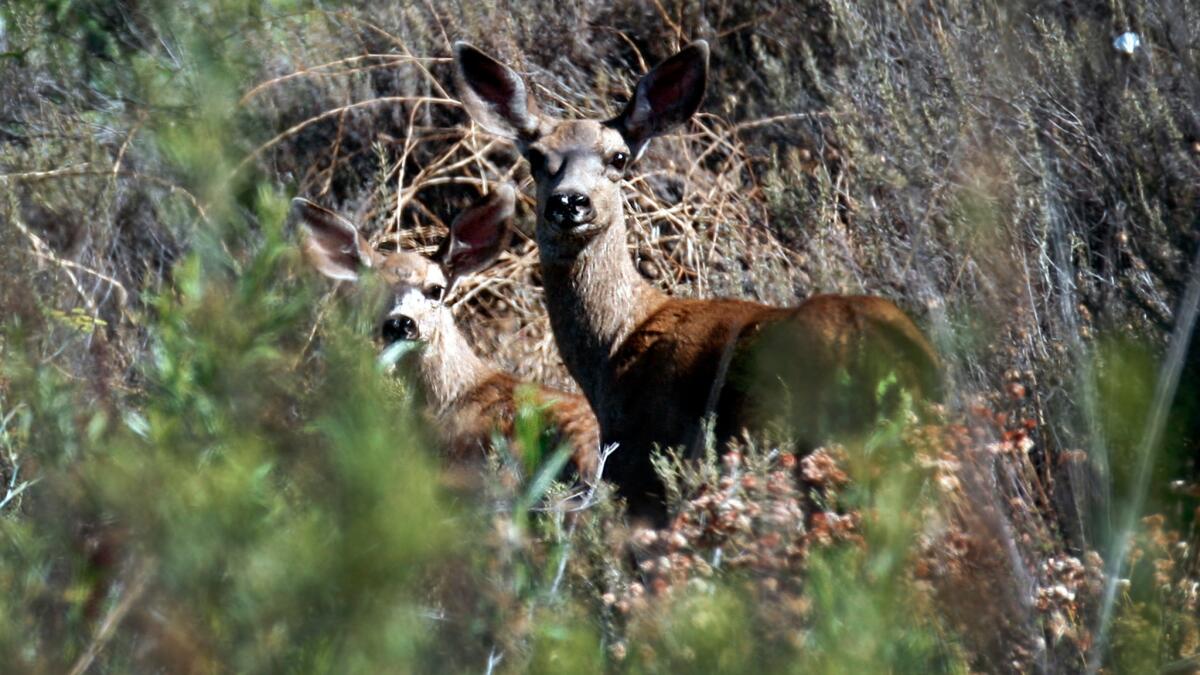To avoid conflict, L.A. mountain lions choose separate hunting grounds
In the hills and wooded areas of the Los Angeles area, mountain lions remain a constant, yet mostly unseen, presence.
But the predators may come closer to human areas to hunt than we previously realized, according to a recent study by UCLA and the National Park Service.
The study, published in PLOS One, tracked mountain lions in and around the Santa Monica Mountains National Recreation Area to see where the predators like to hunt and kill their favorite food: mule deer.
See the most-read stories in Science this hour »
Since 2002, the park service has monitored pings from GPS collars attached to 26 of the cats. Whenever the data revealed a puma lingering at the same location for much of the day, the researchers knew it had probably made a kill.
That’s when a researcher would head out, slog through the thick chaparral and to try to find the carcass. In the end, the researchers logged 420 mule deer kills.
The results offer new insights into how individual mountain lions respond to disruption from urban development and threats from within their own species.
Mountain lions, which can occupy ranges of up to 200 square miles for males and 75 square miles for females, prefer to hunt on steep slopes and in thick vegetation, which give them an advantage when sneaking up on prey.
Males tended to hunt and kill deer in wooded areas near creeks and rivers — habitats that attract plenty of deer.
But to avoid crossing paths with aggressive males, female pumas killed deer closer to developed areas — less than a mile or so away on average.
Urbanized landscapes may be the next best place to find deer outside the riparian woodland preferred by males. Artificial water sources like sprinklers and swimming pools help maintain lush vegetation for deer to munch on, even in drought conditions.

Approaching human-occupied areas isn’t without risks.
The plights of the Los Angeles area’s mountain lions are well-known. Many cats have been struck and killed by cars while attempting to cross freeways, or have been sickened or killed by rodent poison. Due to their isolation from other puma populations, they also face problems from inbreeding.
Within the study area, however, the leading cause of death for mountain lions was other mountain lions, said Seth Riley, a National Park Service wildlife ecologist and a co-author of the study.
Male mountain lions are known to kill fellow pumas in confrontations over prey carcasses, and the problem may be exacerbated in the Santa Monica Mountains.
Typically, males disperse and adopt their own home ranges. But in these mountains, the predators are held in close quarters by freeways and development, Riley said.
“We’ve had virtually no evidence of young males being able to disperse, so many of [them] end up getting killed by close relatives, like their father or brother,” Riley said.
It’s possible the risk to a female or her young of being attacked by a male is greater than the risks posed by venturing near humans, said wildlife ecologist John Benson.
“It could be sort of the lesser of two evils,” said Benson, who led the study as a postdoctoral researcher at UCLA’s La Kretz Center for California Conservation Science.
While some mountain lions came closer to urban environments than the researchers expected, only two actually made kills within developed areas, the study authors noted.
In general, Benson said, mountain lions seem to avoid contact with humans.
“It doesn’t seem like they’re needing to go into backyards or anything like that,” Benson said.
Mountain lions that live near dense urban landscapes, such as Griffith Park or Verdugo Hills, avoided the area by hunting farther away from people. The cats that lived in more remote areas were more willing to approach human settlements to hunt.
“Continued development in areas used by mountain lions adjacent to Los Angeles and other metropolitan areas could reduce the quality of foraging habitat for mountain lions,” the study’s authors suggest.
Benson said focusing on individual-level differences in mountain lions will go a long way toward understanding the animals and ultimately conserving the species.
“A mountain lion isn’t just a mountain lion in the L.A. area, he said. “Its behavior will be a function both of who it is … and also the environment it interacts with.”
Given the challenges they face, Riley said, it’s amazing that mountain lions still live around Los Angeles.
“It really is a testament to the amount of open space people have been able to conserve in Southern California,” he said.
Follow me on Twitter seangreene89 and “like” Los Angeles Times Science on Facebook.
MORE IN SCIENCE
Underwater microscope catches corals dancing in their natural habitat
After asteroid hit, a giant cloud of smoke led to dinosaurs’ demise, study says
DNA from ancient skeletons suggests farming was invented multiple times in the Fertile Crescent







